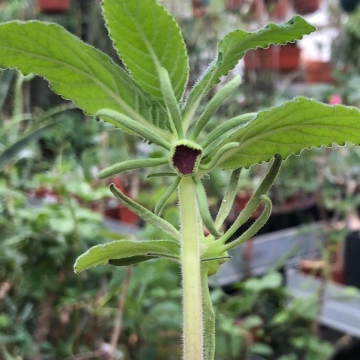
Dorstenia benguellensis Photo by: © Plantemania
Cup shaped flowers.
Origin and Habitat: Angola, Sudan to Cameroon, Southwards to Angola, Zimbabwe and Mozambique.
Altitude range: up to 2450 metres above sea level.
Habitat and ecology: Dorstenia benguellensisSN|33307]]SN|33307]] grows in miombo and mixed deciduous woodlands, wooded or open grasslands, often in local water catchments or among rocks in slopes, in shallow or sandy soils, Kalahari Sand, and seasonally waterlogged grasslands (dambos), often associated with termite mounds, or in montane grassland.
Synonyms:
See all synonyms of Dorstenia benguellensis
back
Accepted name in llifle Database:Dorstenia benguellensis Welw.Trans. Linn. Soc. London 27: 71 1869Synonymy: 25
back
Description: Dorstenia benguellensisSN|33307]]SN|33307]] is a shortly and densely hairy perennial herb, with a swollen rhizomatous or often pachycaul (caudiciform) base and annual aerial stems to 50(-60) cm tall; all parts with a milky latex. The leaves are minutely hairy. The flower has about 8 long and rather narrow receptacle appendages of various lengths. The receptacle is variously shaped, disc or cup shaped.
Derivation of specific name: Benguellensis: from Benguella in Angola.
Tuber (caudex): Fleshy, discoid to depressed-globose or placentiform, (1-)2-4(-12) cm across. rich in latex; surface warty and emitting fibrous roots.
Annual stems: Erect, solitary, cylindrical, herbaceous, sparsely hairy, leafy, subsucculent, 1.5-8 mm in diameter, covered when young with dense whitish pubescence, unbranched or branched (at least with a few short leafy branchlets with reduced leaves) internodes 2-3 cm long, becoming shorter towards the densely leaved apex. The lower part with scale-like reduced leaves (cataphylls) gradually passing into normal leaves.
Leaves: Subsessile or very shortly stalked, spirally arranged, thickish, oblong to subovate to linear or sometimes to subobovate, occasionally elliptic or ovate, (1-)5-7,5 (-15) cm long, (2- )4-16(-45) mm wide, more or less acuminate, apex blunt and obscurely mucronate, base more or less tapering, sometimes obtuse to rounded, margin finely to coarsely toothed, almost glabrous, finely hairy, sparsely hirtellous especially on the nerves; lateral nerves (7–)8-10(-12) on each side, ascending. Leaves on the lower pan of the stem scale-like and entire to tripartite. Stipules linear-tapering to linear-lanceolate, 2-3(-5) mm long, deciduous or persistent. Petiole (0)1–2(5) mm. long c. 1 mm. thick
Inflorescences: Solitary or sometimes in pairs in each leaf-axil; stalk stout, about (3-)5-25(-70) mm long ( increasing sometimes in the fruit), 1–1.5 mm. thick, minutely puberulous to hirtellous or hispidulous. Receptacle yellowish-green, glabrescent, outside convex; disc flat, turbinate, sometimes shallowly cup-shaped, orbicular to elliptic, in outline, (5-)7-8(-25) mm in diameter (increasing in the fruit), margin very narrow; denticulate, fringes triangular to subulate or filiform rather narrow (1-)5 (-7) mm) long or absent. Bract-arms, springing from below the margin, spreading in a whorl, subequal, slender linear, blunt, thickening and sparsely puberulous towards the apex, varying considerably in number and length in different specimens, 7 to 20 in number (rarely few or even 0), (1-)5-20(80) mm long, 0.1-3.5 (-8) mm wide, sometimes slightly dilated at the tip.
Flowers: Male flowers crowded, 2-androus with a bluntly 2-lobed perianth,stamens 2. Female flowers numerous, scattered over the disc, perianth shortly tubular; stigmas (1)2, style deeply 2-lobed.
Fruits: Elongating and forming a stalked 2-valved fleshy structure projecting above the male flowers.
Subspecies, varieties, forms and cultivars of plants belonging to the Dorstenia benguellensis group
Dorstenia benguellensis is extremely variable and forms a complex (The several synonyms refers to previously described species, so similar and intermingled that it is almost impossible to name them accurately without knowing where they come from.) It is not surprising to have caused so much difficulty, because you can find plants with slightly different characteristics growing cheek by jowl in many parts of the areal.
Bibliography: Major references and further lectures
1) Urs Eggli “Illustrated Handbook of Succulent Plants: Dicotyledons” Springer Science & Business Media, 2002
2) J. Hutchinson & A. B. Rendle, “Flora of Tropical Africa”, Vol 6, 1916
3) C. C. Berg, “Flora Zambesiaca” FZ, Vol 9, 1991
4) Burrows, J.E. & Willis, C.K. (eds) (2005). “Plants of the Nyika Plateau” Southern African Botanical Diversity Network Report No. 31 SABONET, Pretoria Page 212.
5) Hyde, M.A., Wursten, B.T., Ballings, P. & Coates Palgrave, M. (2018). “Flora of Zimbabwe”: Species information: Dorstenia benguellensis.
https://www.zimbabweflora.co.zw/speciesdata/species.php?species_id=120160, retrieved 20 August 2018
6) Species accounts – SANBI, web: https://www.sanbi.org/wp-content/uploads/2018/04/sabonet-report-no-31-plants-nyika-plateau-part-3.pdf
 Dorstenia benguellensis Photo by: © Plantemania
Dorstenia benguellensis Photo by: © PlantemaniaSend a photo of this plant.The gallery now contains thousands of pictures, however it is possible to do even more. We are, of course, seeking photos of species not yet shown in the gallery but not only that, we are also looking for better pictures than those already present.
Read More...











